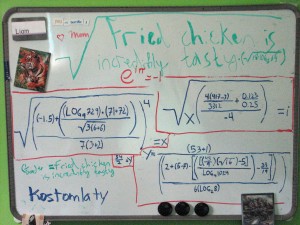As sixth grade was coming to a close in 2011, students passed yearbooks to classmates and teachers. Mr. Beatty wrote a complimentary and encouraging message in Liam’s yearbook. The message ended with a math equation preceded by the words: “Check it out!”
eπi = -1
This equation is called Euler’s Identity (pronounced: oyler). It may also be written as:
eπi + 1 = 0
I remember standing in Liam’s room with him when he told me about Mr. Beatty’s invitation to explore this equation. It’s written on Liam’s dry-erase board in his room. I can’t remember clearly whether Liam or I wrote it. But I know we shared the moment in some form or fashion because the equations on the board relate to the days when I went back to school to Whatcom Community College to work toward a science degree.
When Liam was in his first year of middle school, I was reviewing logarithms, geometry and trigonometry. This led our family to discuss math a lot, and Liam easily became absorbed. In particular, as Liam came to grasp the idea of logarithms, the dry-erase board soon beheld one long logarithmic equation that even involved chicken!

Liam was certainly poised to check out Mr. Beatty’s equation. I imagined a future of sharing more math with Liam – as well as chemistry and geology. Liam was poised to learn so much.
Later, in 2015, I enrolled in five weeks of Taylor Series*. It was in this class that I learned about Euler’s Identity and that it is a wondrous equation derived from Euler’s Formula:
eπi = cosx + isinx
which in turn relates real numbers to imaginary numbers such as i, otherwise known as:
√-1

√-1 = i
Imagine that! What’s real can be related to what is imaginary! However you choose to look at it – mathematically or in your imagination – this is just one more idea I would love to talk about with Liam. And so …
Here’s an idea to think about:
Proving and deriving math equations is like deconstructing words into their roots, oceans into organisms and minerals, machines into smaller mechanisms. There is more than one way to prove Euler’s Formula. *Using Taylor series is one of those ways. With Taylor series, one would expand the exponential function, exi, and the trigonometric functions, cosx and sinx, into series of terms, then relate those series of terms to each other.
To derive Euler’s Identity from Euler’s Formula, substitute x with π. Therefore: exi = cosx + isinx becomes eπi = cosπ + isinπ, and eπi = -1 !!
eπi = cosx + isinx
Click equation
Now use Euler’s Formula to derive Euler’s Identity:
